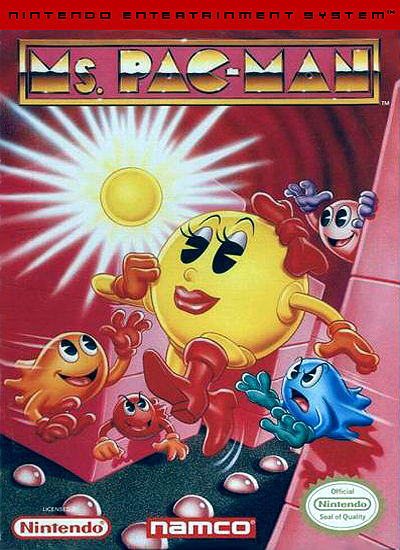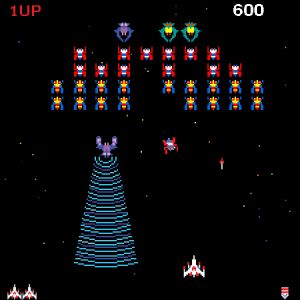Pac-Man
Originally titled Puck Man, Pac-Man hit the arcade scene first in Japan when Namco released it on May 22, 1980. Shortly after receiving a lukewarm response in Japan the game was released in the U.S. by Midway. Compared to other arcade hits in the early '80s, such as Space Invaders,Defender, and Asteroids, Pac-Man put a friendlier face on its bizarre action and thus had the ability to appeal to a much broader audience.
The basic premise of the game involves the character, Pac-Man, a yellow circle with a slice cut out for a mouth (said by developer Toru Iwatani to represent a pizza with one missing slice, as well as the general idea of a mouth eating). In the 256 levels of the game, the player controls Pac-Man through a maze in which he has to eat up all the dots on the screen. But here's the catch: four ghosts, Blinky, Pinky, Inky and Clyde, inhabit each level and actively try to eat Pac-Man. If Pac-Man runs into any of the ghosts, a life is lost. If, however, Pac-Man eats any of the four "power pellets" found in the game, the ghosts become temporarily edible. If Pac-Man eats them, their eyes drift back into the center of the level to regenerate into their previous ghost form. Players can also get point bonuses by eating fruit pieces throughout the level. The primary goal is to maneuver around the level and eat up the dots without being killed off.
On July 3, 1999, scoring regulatory body Twin Galaxies recorded Billy Mitchell as the only player to complete all 256 levels with maximum points and no lives lost. This was especially difficult given that the last level of Pac-Man is ridden with bugs, with the right half of the screen featuring only garbled text.
There's no question that Pac-Man is a seminal arcade classic and helped define an entire decade's pop culture.
Ms. Pac-Man
The idea of Ms. Pacman was not by Namco, but by hackers. The first version of Ms. Pacman was created in 1981 by a handful of programmers at General Computer Corporation. The programmers took a Pacman cabinet, and modified it, calling it Crazy Otto.
 Ms. Pac-Man Box Art (NES, Namco)
Ms. Pac-Man Box Art (NES, Namco) The programmers, showed it to Midway, who were both surprised at the quality of Crazy Otto, and were getting upset over the long period of time between the original Pac-man, and it's sequel. Midway bought the rights for Crazy Otto, and added the Pac-man sprites, and the iconic name, Ms. Pacman to the once bootleg game.
As Ms. Pacman became more and more popular, Namco noticed this very quickly. Midway had not gotten consent from Namco to publish the game in the first place, and with that a legal battle was about to erupt. Fearing a case would be brought against themselves, Midway and GCC turned over the rights for Ms. Pac-man to Namco. Afterwards, Namco created numerous ports for the home consoles, while benefiting from the widely popular arcade game, that was soon becoming a cultural phenomenon.
Gameplay
Ms. Pac-man's gameplay does not stray much from Pac-man's gameplay of eating pellets, eating power pellets to eat ghosts, and eating numerous types of fruit. Though there are a few major changes that would change the gameplay experience between both games.
- The first such change is the three scenes after each level is completed. They scenes tell the story of how they first meet, dating, and when the stork drops off their baby.
- The second change is a minor one; the changing of the orange ghost's name from Clyde to Sue.
- The ghosts now have movements that are semi-random. Because of this, many players have learned to use a set of moves to avoid the ghosts.
- The fruit no longer appears and stays in the center of the maze. It instead enters from one tunnel of the maze, travels around, and will leave through the other tunnel if not eaten by the player.
- The fruits order is now cherries, strawberry, orange, pear, apple, pretzel, banana. The score for each is also 100, 200, 500, 700, 1000, 2000, 5000.
- The final change is that there are six different mazes. With each maze there are four different kinds of color, or style that is in each one. Each maze also now had two warp tunnels, that will transport the player to the opposite side of the maze, as well as the walls now being filled in. (Pac-man had hollow walls.)
Galaga
Released in 1981, Galaga has become one of the most popular arcade games of all time. Much more well received than its predecessor,
Galaxian, Galaga features fast paced
top-down shooting action. The player takes control of a small ship located at the bottom of the screen and is tasked with destroying the incoming waves of insect-like enemies.
 Tractor-beam
Tractor-beamGameplay
Player ship movement is restricted to only the left and right. Upon the start of a level, waves of enemies fly in formation and complete a flight pattern before positioning themselves at the top of the screen. It is ideal to destroy the incoming ships before they complete their fly-in. Once in formation at the top of the screen, enemies will regularly break off to attack. Enemy ships attack by dropping bombs and/or colliding with the player's ship.
The most popular and effective strategy is for the player to sacrifice their own ship to a "Boss Galaga" ship. These ships hover above the player and emit a tractor-beam. Entering this beam will sacrifice the current ship and allow the player to use on of the reserves. Destroying the "Boss Galaga" will reclaim the captured ship. The player is then rewarded with double-ships which effectively doubles the player's firepower.
Additionally, a bonus stage occurs every four levels, allowing the player to earn extra points without the risk of being destroyed.
Galaxian
Originally released in 1979,
Galaxian was one of the early arcade games that is still considered a classic. Developed by Namco and released by Midway, it is a fixed shooter arcade game, and is characteristic of the genre, which was created by the release of
Space Invaders a year earlier.
Galaxian stays true to the formula established by
Space Invaders, in that you control a spaceship at the bottom of the screen and must destroy groups of ships at the top of the screen by means of shooting. The main gameplay addition offered by
Galaxian to the
Space Invaders formula is the kamikaze like behavior of enemy ships. The rate of shooting is relatively slow, however your weapon is reloaded immediately upon a successful hit. Once a wave is conquered, another one, with increased difficulty, would replace it.
Galaxian also offered multi colored animated sprites (including explosions), theme music, background music, and representative icons to indicate number of lives left. These were not brand new additions to video games, however
Galaxian's use of them would influence game development over the next several years.
The game was considered a success and spawned the even more successful sequel,
Galaga, in 1981.
Galaxian's success drove the development of several versions for various home consoles, and can found collected in various
Namco Museum collections for modern day consoles.
Pole Position
Pole Position was an arcade game released in 1982, developed by
Namco. The game is seen as revolutionary for its popularization of sprite based, pseudo-3D
graphics. It was one of the first games to use the "rear-view racer format" that would change the way in which racing games were developed. Pole Position was also one of the first games to feature in-game advertising.
When looking for a publisher in the United States, Namco originally approached
Midway with a choice between two games,
Pole Position or
Mappy. Midway chose Mappy and Namco turned to
Atari to publish the game. Midway would miss out on a large opportunity as Pole Position became one of the most popular arcade games of 80s and was ported to an assortment of different consoles. The game even spawned its own Saturday morning cartoon show on CBS.
Dig-Dug
You play as Dig Dug (who is also known as
Taizo Hori in other games that he appears in)
, a pump wielding spelunker who faces several enemies while he digs
underground. The object of each level (or board) is to clear it of all of the enemies before they kill you by walking to within a set distance and pushing the button to fill the up with air until they explode. Another more strategic way to dispatch your enemies would be to dig underneath
boulders that are located on each level and drop them on to to enemies that are below them. It could be argued that this was one of the first major acts of violence in a video game, but due to it's cartoon like nature it was probably overlooked at the time. The original game was released into arcades by Namco in 1982, and contained the standard (at the time) of 256 levels before you reached a
"kill screen" and the game either froze up or reset itself.
Another source of scoring points throughout the game is the inclusion of a fruit or item in the center of the screen that would appear after dropping two of the levels boulders. This mechanic is very similar to another Namco game series,
Pac-Man. The boulders did not have to drop on enemies for the fruits to appear however. The bonus items include :
Carrot, Turnip, Zucchini (or Cucumber),
Eggplant, Green Pepper,
Tomato,
Garlic,
Watermelon,
Pineapple, as well as the inclusion of a Warship from Namco's
Galaxian.
Enemies
 PookaPooka:
PookaPooka: Best described as a round orange ball with aviator goggles, Pooka is the most common enemy that you will face in the game. Not as overly aggressive as his counter part, he as well as Fygar still has the ability to pass through the un-dug parts of the dirt in each level to attack you from any angle.
Fygar: A dragon-like creature, not only can he pass through the dirt and attack you but also has the ability to breathe fire, making him a decidedly more difficult and deadly enemy.
LegacyDig-Dug is considered to be a classic and has spawned many
sequels and has appeared on many
compilations and game download services since its initial release. The character of DIg-Dug also has a son named
Susumu Hori ( that appears in the
Mr. Driller series), continuing the family legacy of digging to the depths of the earth.
Log in to comment